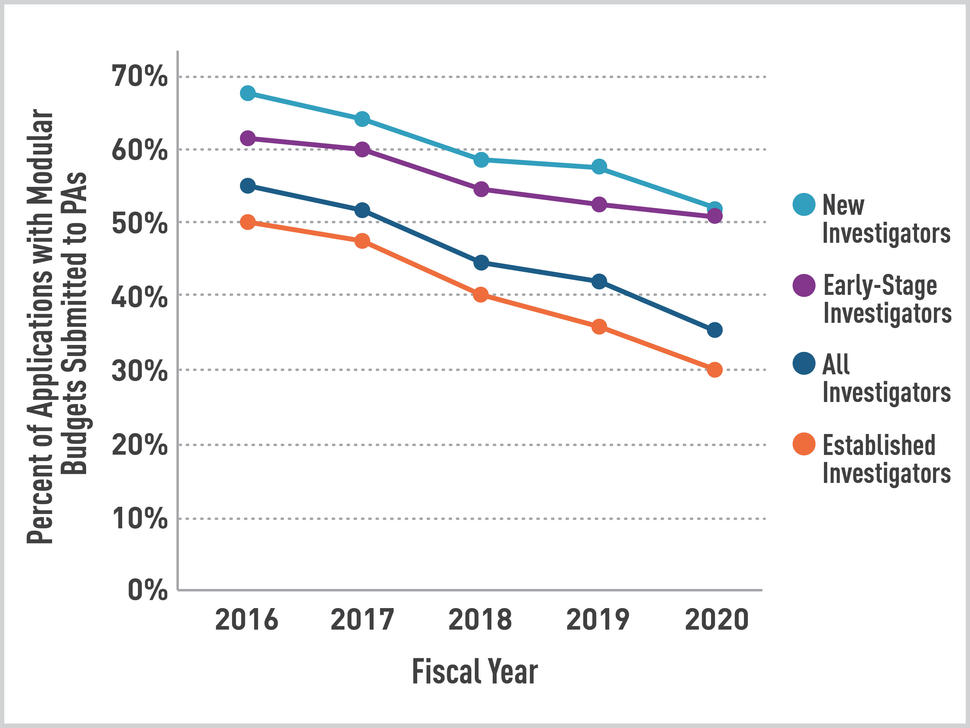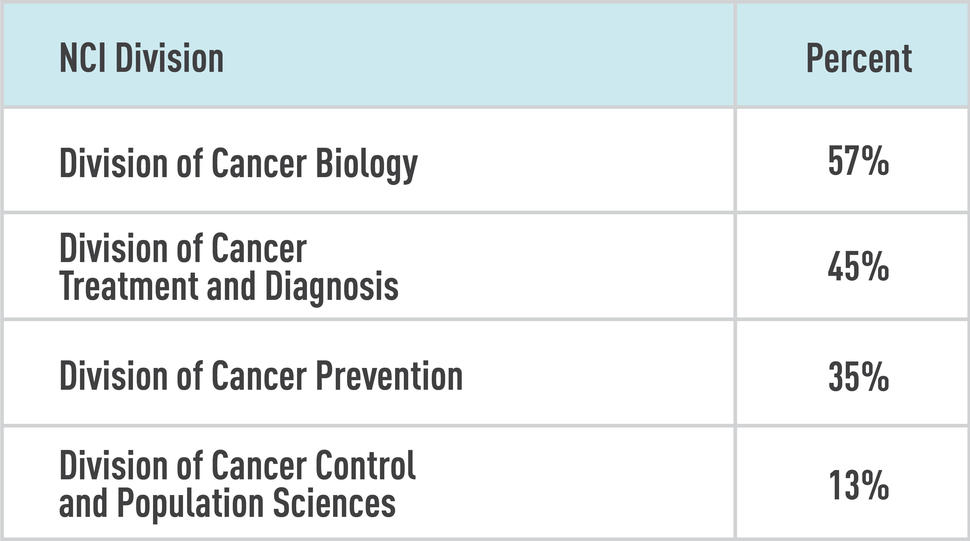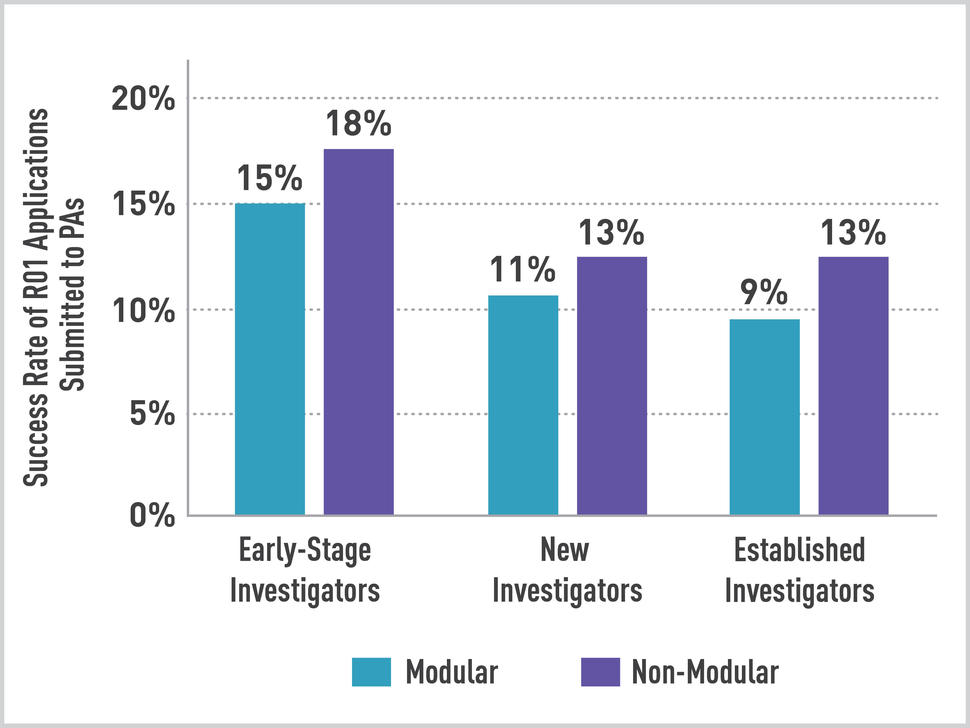Modular versus Non-Modular Budgets: What's the Bottom Line?
, by Dr. Norman E. Sharpless
As NCI Director, Dr. Sharpless gives many presentations to the cancer research community. Questions frequently emerge during these presentations about using the modular budget option with R01 grant applications. In this blog post, Dr. Sharpless discusses an analysis conducted by the NCI Center for Research Strategy (CRS) that addresses questions about the modular budget option.
“Should I submit a modular budget or a non-modular budget with my R01 grant application?”
“As an early-stage investigator (ESI), do I have a better chance of success (receiving a score in the fundable range) if I submit a modular budget with my R01 application?”
These are two questions investigators commonly ask. To get at these questions, NCI performed an analysis of modular and non-modular R01 applications submitted in response to NIH Program Announcements (PAs)1. Based on this analysis, a principal investigator should submit a grant application with the right-sized budget for the research being proposed.
Here’s the history and the analysis:
NIH introduced the modular budget for R01 applications in 1998 to streamline the grant application process. Investigators who submit an R01 application with a modular budget can request up to $250,000 in direct costs for their proposed research without including a detailed budget. The modular budget option can significantly ease the application process. The cap of $250,000 in direct costs has been in place since NIH established the modular budget policy.
Alternatively, investigators can request more than $250,000 in direct costs by submitting a detailed non-modular budget with their R01 application. Certain R01 applications, such as those from foreign institutions, cannot use a modular budget (see the NIH website for more information).
Is it more common for NCI R01 applicants to include a modular or a non-modular budget?
To address this question, CRS examined how frequently R01 grant applicants included modular budgets compared with non-modular budgets during fiscal year (FY) 2016 through FY 2020. CRS then analyzed the trends in success rate for applications with modular versus non-modular budgets.
As Figure 1 highlights, the use of the modular budget continually decreased throughout the period CRS analyzed, from about 55% in FY 2016 to about 35% in FY 2020. The decline translates to a decrease of about 500 modular applications with a concomitant increase of almost 1,000 non-modular applications. The largest percent decrease in modular applications was from established investigators (EIs), although the percent of applications with modular budgets also decreased for new investigator (NI) and ESI applications.
It’s noteworthy that the use of the modular budget is not uniform across NCI divisions. NCI has four extramural divisions that focus on distinct areas of cancer research: basic cancer biology, cancer diagnosis and treatment, cancer prevention, and cancer control and population sciences. As Figure 2 shows, NCI’s Division of Cancer Biology, which has the largest R01 portfolio, received the highest percentage of R01 applications with modular budgets. Of course, research costs differ by discipline. For example, prevention and population science research tends to be more expensive. This may contribute to the differences seen in Figure 2.
Do non-modular R01 applications submitted to NCI have a lower success rate than modular R01 applications?
Investigators sometimes express concern that a non-modular budget might adversely affect their application during peer review, leading to a score outside the fundable range. This concern overlooks the fact that reviewers do not discuss budgets until after they provide final impact scores, and then reviewers only comment on the appropriateness of the budget in the context of the research proposed.
The CRS analysis shows that non-modular applications had a slightly higher NCI success rate than modular applications during the time frame studied and for the parameters CRS examined (Figure 3). This trend held true for ESI, NI, and EI applications. NCI recognizes that the modest differences in success rate may relate to factors other than whether the application contained a modular or non-modular budget. Although the CRS analysis did not account for the many factors that can affect the success rate for R01 applications, it did not identify a disadvantage if grant applicants submit a non-modular budget.
The trend of a higher success rate for non-modular applications also holds when the data are broken down by extramural division. For each of the four divisions noted in Figure 2, the success rate for non-modular applications was higher than for modular applications.
Overall, 55% of new R01 applications submitted in response to PAs during FY 2016 through FY 2020 included non-modular budgets. As shown in Figure 3, the success rate for these applications was slightly higher compared with the success rate of applications that included modular budgets. This indicates that investigators, whether early stage or otherwise, do not lower their chance of success when submitting a non-modular budget with their application.2 Of course, the decision on which type of budget to choose may be influenced by many factors, including the nature of the research proposed and requirements established by the investigator’s sponsoring institution.
The bottom line is that investigators should submit an application with a budget that is most appropriate for the research they propose to conduct.
1. The analysis of NCI R01 applications submitted in response to NIH PAs excludes: 1) requests for applications (RFAs), and 2) applications to PAs with special receipt dates and special referral and/or review considerations (known as PARs). Also, the analysis included only new (Type 1) R01 applications to PAs that were reviewed and when a resubmission application was submitted in the same FY as the original application, the two applications were counted as one. Established investigator, new investigator, and early-stage investigator status was determined based on the characteristics of the application.
2. The conclusions are based on NCI application and award data only, and these conclusions should not be applied to applications submitted to other NIH institutes.



